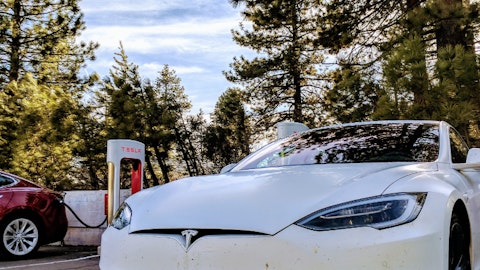In this article, we discuss 5 best energy ETFs to invest in. If you want to read our discussion on the energy industry, head directly to 12 Best Energy ETFs: Top Oil, Gas and Renewable Energy Funds.
5. ALPS Clean Energy ETF (NYSE:ACES)
5-Year Performance as of July 28: 83.70%
ALPS Clean Energy ETF (NYSE:ACES) seeks to replicate the performance of the CIBC Atlas Clean Energy Index. The ETF provides investors with access to US and Canadian companies operating in the clean energy industry, encompassing renewables and clean technology. ALPS Clean Energy ETF (NYSE:ACES) was launched on June 28, 2018, and as of July 27, 2023, it holds net assets totaling $499.5 million, with a total expense ratio of 0.55%. ALPS Clean Energy ETF (NYSE:ACES) is one of the best energy ETFs to monitor.
Tesla, Inc. (NASDAQ:TSLA) is a significant holding of ALPS Clean Energy ETF (NYSE:ACES). On July 19, Tesla, Inc. (NASDAQ:TSLA) reported a Q2 non-GAAP EPS of $0.91 and a revenue of $24.93 billion, outperforming Wall Street estimates by $0.09 and $200 million, respectively. Tesla also announced a new record for deliveries during the second quarter of 2023, achieving a total of 466,140 vehicles, surpassing expectations.
Baron Opportunity Fund made the following comment about Tesla, Inc. (NASDAQ:TSLA) in its Q1 2023 investor letter:
“Tesla, Inc. (NASDAQ:TSLA) designs, manufactures, and sells EVs, related software and components, and solar and energy storage products. Following a sharp decline at the end of 2022, Tesla’s stock rebounded in the first quarter of 2023 on investor expectations that Tesla will continue to grow vehicle deliveries and maintain solid gross and operating margins despite a potential recession, competition in China, and vehicle price reductions. We wrote a long piece on Tesla last quarter and refer readers back to it, because for long-term investors not much has changed over the last three months. Tesla did hold its first Investor Day in March, and several Baron analysts and portfolio managers attended. We toured the Austin Gigafactory, drove in a Cybertruck, boarded a Semi truck, and spoke with a wide swath of Tesla senior managers. During the formal presentation, Tesla highlighted, among other things: (1) its broad and deep bench of executive talent supporting CEO Elon Musk; (2) its “Master Plan 3–Sustainable Energy for All of Earth,” which featured EVs, renewable power from solar and wind, and stationary electric storage; (3) its vehicle assembly innovations, including massive casted parts (building Model Y bodies with single front and rear castings, replacing a substantial number of parts and fastening steps), a stainless steel exoskeleton (for Cybertruck), and its next-generation highly efficient “unboxed process” for its next-gen $25,000 vehicle; (4) a future permanent[1]magnet electric motor that will not require any rare earths; and (5) the massive untapped market opportunity for commercial stationary electric storage, branded Megapack, as the world steadily shifts to renewable energy. As long-term shareholders, we have witnessed Tesla exploit its innovative Model 3/Y now-global mass-market platform to increase vehicle deliveries from barely a standing start to over 1.3 million units, while achieving industry-leading margins and reinforcing its iron-clad balance sheet to almost $23 billion in cash (and effectively no recourse debt). We expect Tesla’s next-generation EV and Megapack products to have a similar impact on company results.”





